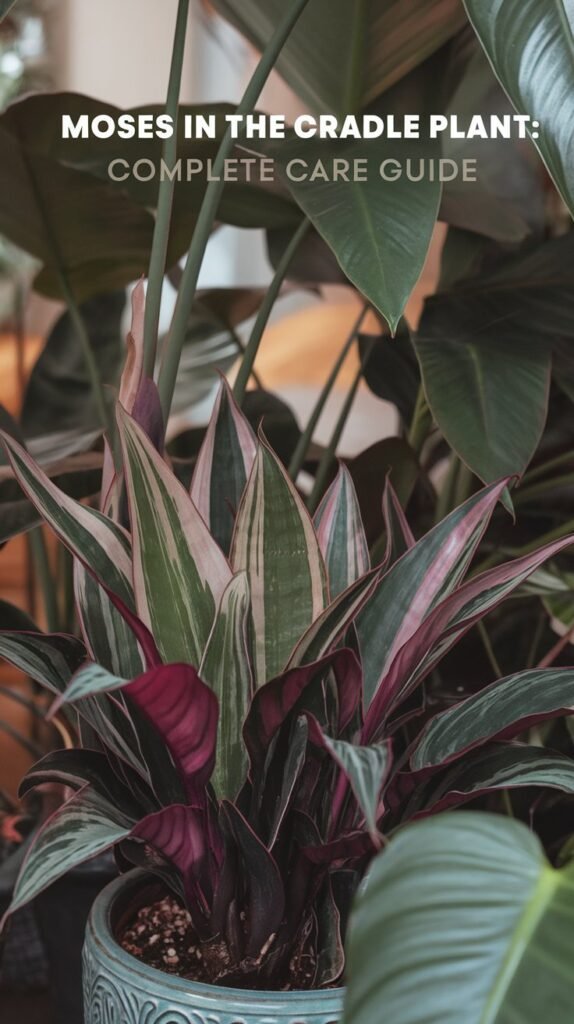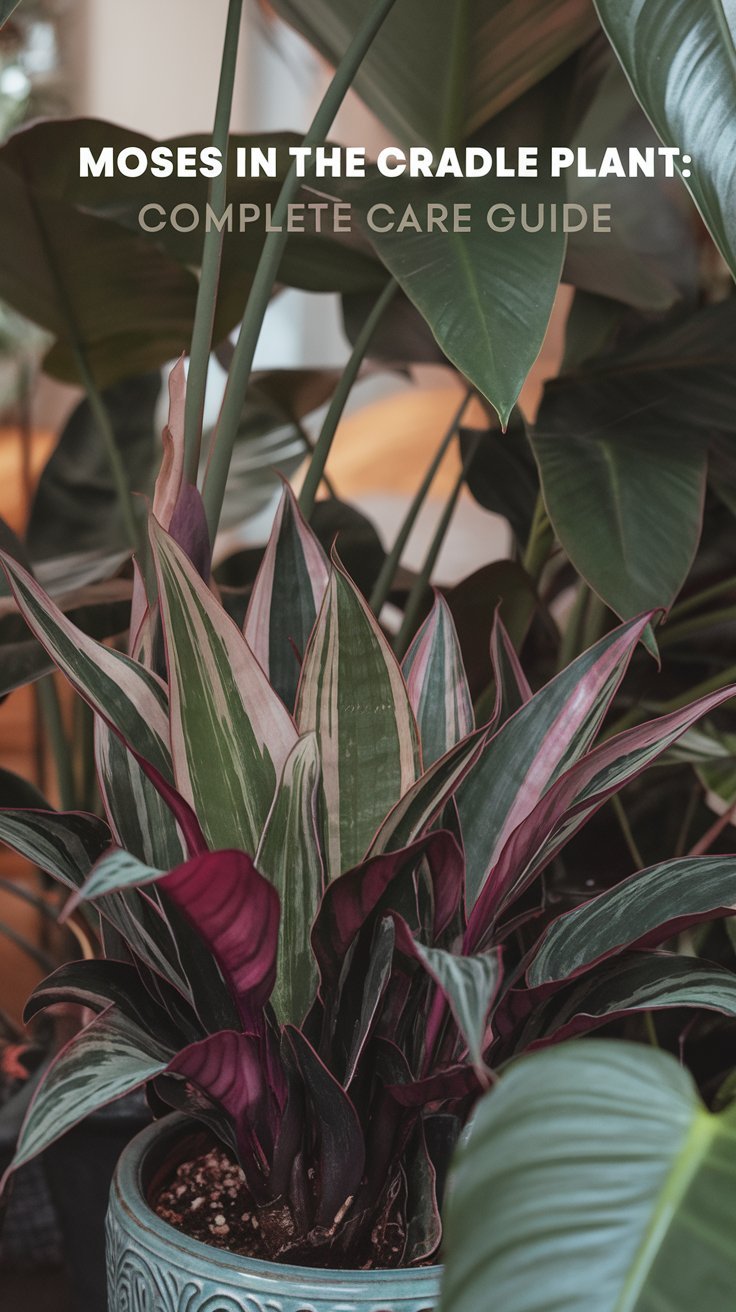Discover how to grow and care for the striking Moses in the Cradle plant (Tradescantia spathacea). Learn about its unique features, ideal growing conditions and tips for maintaining this colorful, low-maintenance houseplant.
Moses in the Cradle Plant (Tradescantia spathacea) is a striking houseplant known for its colorful, sword-like leaves and unique white flowers nestled in purple boat-shaped bracts. This low-maintenance plant is perfect for both novice and experienced plant enthusiasts, thriving in bright indirect light and moderate humidity.
As a botanist with over a decade of experience cultivating tropical plants, I’m excited to share my expertise on caring for this beautiful species. Let’s dive into everything you need to know about growing and maintaining Moses in the Cradle plants.
Quick Facts About Moses in the Cradle

- Scientific Name: Tradescantia spathacea (formerly Rhoeo spathacea)
- Common Names: Moses in the Cradle, Boat Lily, Oyster Plant
- Plant Family: Commelinaceae
- Origin: Native to Central America, particularly Mexico and Belize
- Growth Habit: Herbaceous perennial
- Height: Typically 12-18 inches (30-45 cm)
- USDA Hardiness Zones: 9-11
Why Grow Moses in the Cradle?

This plant offers several benefits:
- Striking foliage with purple undersides
- Air-purifying qualities
- Low-maintenance care requirements
- Unique flowers nestled in colorful bracts
- Easy to propagate
How to Grow Moses in the Cradle
Light Requirements
- Thrives in bright, indirect light
- Can tolerate some direct morning sun
- Avoid harsh afternoon sunlight, which can scorch leaves
Temperature and Humidity
- Prefers warm temperatures between 60-80°F (15-27°C)
- Tolerates average household humidity
- Increase humidity with a pebble tray or humidifier for optimal growth
Soil and Potting
- Use well-draining potting mix
- Add perlite or coarse sand to improve drainage
- Choose a pot with drainage holes
- Repot every 2-3 years or when rootbound
Watering
- Allow top inch of soil to dry between waterings
- Water less frequently in winter
- Avoid overwatering to prevent root rot
Pro tip: Use filtered water or let tap water sit out overnight to reduce fluoride and chlorine content, which can cause leaf tip browning.
Care and Maintenance
Fertilizing
- Feed monthly during growing season (spring and summer)
- Use balanced, water-soluble fertilizer diluted to half strength
- Reduce or stop fertilizing in fall and winter
Pruning and Grooming
- Remove dead or yellowing leaves regularly
- Pinch back leggy growth to encourage bushiness
- Trim off flower stalks after blooming if desired
Propagation
Moses in the Cradle is easy to propagate:
- Take 4-6 inch stem cuttings
- Remove lower leaves
- Place in water or moist potting mix
- Roots should develop in 2-3 weeks
Common Problems and Solutions
Pest Management
While generally pest-resistant, watch for:
- Mealybugs: Treat with insecticidal soap or neem oil
- Spider mites: Increase humidity and use miticides if necessary
Disease Prevention
- Root rot: Ensure proper drainage and avoid overwatering
- Leaf spot: Remove affected leaves and improve air circulation
Decorating with Moses in the Cradle
This versatile plant works well in various settings:
- As a colorful tabletop accent
- In hanging baskets for trailing varieties
- As part of a tropical-themed plant grouping
- In outdoor containers in warm climates
Toxicity Concerns
Moses in the Cradle contains calcium oxalate crystals, which can cause:
- Mouth and throat irritation if ingested
- Skin irritation in sensitive individuals Keep out of reach of children and pets.
Frequently Asked Questions
- Why are my Moses in the Cradle leaves turning yellow? Yellowing leaves often indicate overwatering. Ensure proper drainage and allow the soil to dry between waterings.
- How often does Moses in the Cradle bloom? While primarily grown for its foliage, it can bloom sporadically throughout the year, especially in bright light conditions.
- Can I grow Moses in the Cradle outdoors? Yes, in USDA zones 9-11. In colder regions, it can be grown as an annual or brought indoors during winter.
Related Plants and Varieties
- Tradescantia zebrina (Wandering Jew)
- Tradescantia pallida (Purple Heart)
- Tradescantia fluminensis (Small-leaf Spiderwort)
For more information on tropical houseplants, visit the International Aroid Society website.
Remember, every plant is unique, and it may take some time to find the perfect care routine for your Moses in the Cradle. Don’t be afraid to experiment and adjust your care based on your plant’s response. Happy growing!
For more gardening tips and plant care guides, visit usagardenhub.com





2 Comments on “Moses in the Cradle Plant : Complete Care Guide”